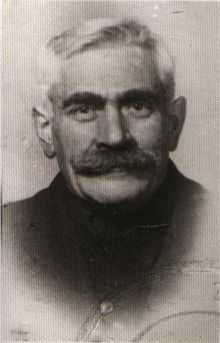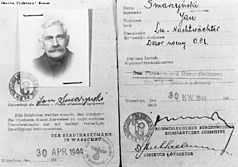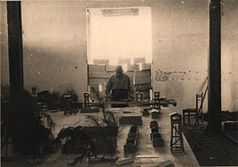Jankiel Wiernik
| Jankiel Wiernik | |
|---|---|
 Jankiel Wiernik | |
| Born |
1889 Biała Podlaska |
| Died |
1972 Rishon Lezion |
Cause of death | natural causes |
Resting place | Israel |
| Occupation | Master Carpenter |
| Known for | Participation in the uprising of Treblinka and testimony at the Eichmann trial |
| Home town | Kobrin, Poland |
| Religion | Jewish |
| Part of a series on | ||||||||||
| The Holocaust | ||||||||||
|---|---|---|---|---|---|---|---|---|---|---|
 | ||||||||||
|
||||||||||
|
||||||||||
|
Atrocities
|
||||||||||
|
Camps
|
||||||||||
|
Allied response |
||||||||||
|
Resources |
||||||||||
|
Remembrance
|
||||||||||
Jankiel (Yankel or Yaakov) Wiernik (in Hebrew: יעקב ויירניק; born 1889, Biala Podlaska, Poland; he had first lived in Kobrin, Poland but he and his father, both master cabinetmakers, did not wish to be in competition with family members (Natan Wiernik) who were also master cabinetmakers, thus they moved to Biala Podlaska. Yankel died in 1972, Rishon Lezion, Israel)[1] was a Polish-Jewish Holocaust survivor who was an influential figure in the Treblinka extermination camp uprising. After his escape during the uprising of 2 August 1943, Wiernik wrote a clandestine account of the camp's operation titled A Year in Treblinka consisting of his experiences and eyewitness testimony of a Sonderkommando slave worker at a Nazi secretive death camp responsible for the annihilation of anywhere from 700,000 to 900,000 innocent victims.[2]
Following World War II Wiernik testified in the Ludwig Fischer's trial in 1947, the Eichmann Trial in 1961, and was present at the opening of the Treblinka Memorial in 1964. After the Soviet takeover, Wiernik emigrated to Sweden and later relocated to Israel where he died in 1972 at the age of 83.
Life
Jankiel Wiernik was a member of the "Bund" movement from 1904.[3] He lived in Warsaw and worked as a property manager at a house owned by the family of Stefan Krzywoszewski (1886-1950), popular writer, publisher and theatre director in the Interbellum. When the World War II began with the 1939 invasion of Poland, he was 50 years old. In late 1940 the German Nazis created the Warsaw Ghetto and Wiernik was forced to relocate there along with all Polish Jews in the capital. He was transported to Treblinka on August 23, 1942 during the murderous Grossaktion Warsaw. Following his successful escape from the extermination camp Krzywoszewski family rescued him.[4]
Treblinka
On his arrival at Treblinka aboard the Holocaust train from Warsaw, Wiernik was selected to work rather than be immediately killed.[4] Wiernik's first job with the Sonderkommando required him to drag corpses from the gas chambers to mass graves. Wienik was traumatized by his experiences. He later wrote in his book: "It often happened that an arm or a leg fell off when we tied straps around them in order to drag the bodies away."[5] He remembered the horrors of the enormous pyres, where "10,000 to 12,000 corpses were cremated at one time." He wrote: "The bodies of women were used for kindling" while Germans "toasted the scene with brandy and with the choicest liqueurs, ate, caroused and had a great time warming themselves by the fire."[6] Wiernik described small children awaiting so long in the cold for their turn in the gas chambers that "their feet froze and stuck to the icy ground" and noted one guard who would "frequently snatch a child from the woman's arms and either tear the child in half or grab it by the legs, smash its head against a wall and throw the body away."[7] At other times "children were snatched from their mothers' arms and tossed into the flames alive." However, he was also encouraged by the occasional scenes of brave resistance.[8] In chapter 8, he describes seeing a naked woman escape the clutches of the guards and leap over a ten foot high barbed wire fence unscathed. When accosted by a Ukrainian guard on the other side, she wrestled his machine gun out of his grasp and shot two guards before being killed herself.
When Wiernik's profession as a carpenter was accepted, he was put to work constructing various camp structures including additional gas chambers. Given his skills, Wiernik was not subjected to the same treatment others were and he no longer had to handle dead bodies. He attributed his survival to building structures needed in the camp. Given the shortage of skilled construction workers accustomed to the killing process, Wiernik moved between the two divisions of the camp frequently. As a result, he became an important contact between the camp zones when the revolt was being planned.
The escape


Wiernik escaped Treblinka during the revolt of the prisoners on "a sizzling hot day" of August 2, 1943. A shot fired into the air signalled that the revolt was on. Wiernik wrote that he "grabbed some guns" and, after spotting an opportunity to make a break for the woods, an axe. A camp guard in hot pursuit shot Wiernik with a pistol but the bullet didn't penetrate his skin. Wiernik said he then turned around and dispatched his pursuer with the axe.[9] Wiernik continued on to Warsaw hiding in a freight train. He hid in Warsaw, secreted initially by the Polish family of Krzywoszewski, his former employers, who got for him false Kennkarte document by the name of Kowalczyk, and then by a woman named Bukowska. Next, Wiernik assumed the name of Jan Smarzyński. He made contact with members of Jewish underground working in the 'aryan' part of Warsaw and was recognised by them as a valuable eyewitness of the extermination process in Treblinka. He was persuaded in late 1943 to write A Year in Treblinka in spite of his initial reluctance (Wiernik had little education and was not a skilled writer). He continued to live in Warsaw in relative comfort believing that his 'aryan' appearance allowed him to do so. He took part in the 1944 Warsaw Uprising fighting in the Armia Ludowa.[4][3] After the end of World War II, Wiernik initially remained in Poland (in 1947 he testified in the trial of Ludwig Fischer),[4] then immigrated to Sweden and afterwards to the newly founded state of Israel. In the 1950s, Wiernik built a model of the Treblinka camp which is displayed in the Ghetto Fighters' House museum in Israel. In 1961 Wiernik testified in the Eichmann trial in Israel.
Wiernik experienced the after-effects of his experience. His feeling of guilt can be seen in chapter one of A Year in Treblinka. "I sacrificed all those nearest and dearest to me. I myself took them to the place of execution. I built their death chambers for them." He stated that he had nightmares and had trouble sleeping. Apparently, the horrors he had experienced in Treblinka had caused him to suffer from survivor syndrome, a form of post-traumatic stress disorder.
A Year in Treblinka
Jankiel Wiernik published Rok w Treblince (A Year in Treblinka) in 1944 as a clandestine booklet printed through the efforts of Jewish National Committee (Żydowski Komitet Narodowy, ŻKN), Bund (underground organisations of the remnants of Polish Jews) and Polish Council to Aid Jews Żegota by means of an underground printer organized by Ferdynand Arczyński. The circulation was estimated by Władysław Bartoszewski as 2,000 copies. It was sent through Polish underground channels to London, translated into English and Yiddish and printed in USA by American Representation of the General Jewish Workers Union of Poland.[4] It was printed in Palestine by the Histadrut in December 1944, translated into Hebrew by Icchak Cukierman.[3] The book recounts his experiences in the Treblinka extermination camp between 1942 and 1943.
See also
Memoir/dp/1605981397/ref=cm_rdp_product The Last Jew of Treblinka]
- Operation Reinhard, the most deadly phase of The Final Solution
- Wannsee Conference of January 20, 1942
| Wikimedia Commons has media related to Jankiel Wiernik. |
References
- ↑ Ghetto Fighters' House Archives, Ya'akov Wiernik. His presence at the Ghetto Fighter's Museum was discovered by third cousin, once removed, Miriam Warnick in the United States. His family who had fled Poland in the early 1900s had thought him dead until they read of his testimony in the Eichmann trial in Israel. His first cousin, now Nathan Warnick could not be persuaded to contact Yankel out of survivor guilt, thus it was leftup to Nathan's granddaughter, Miriam, to research and find Yankel's fate and final location in Haifa Israel.
- ↑ Answers.com, Treblinka.
- ↑ 3.0 3.1 3.2 "Lohami Ha'Gettaot Musium site (hebrow) Ghetto Fighters' House archives.
- ↑ 4.0 4.1 4.2 4.3 4.4 Władysław Bartoszewski, Historia Jankiela Wiernika (The Story of Jankiel Wiernik) in Ten jest z ojczyzny mojej... pp. 633-634, available online at WladyslawBartoszewski.blox.pl as reprint from Miesięcznik "Polska" (monthly), Warsaw Nr 8 / August 1964.
- ↑ A Year in Treblinka, chapter 3.
- ↑ A Year in Treblinka, chapter 9.
- ↑ A Year in Treblinka, chapter 7.
- ↑ A Year in Treblinka, chapter 8
- ↑ A Year in Treblinka, chapter 14.
- Yankel Wiernik (1945), A Year in Treblinka: An Inmate who Escaped Tells the Day-to-day Facts of One Year of His Torturous Experience (see scanned 1945 original in PDF format), New York: digitized by Zchor.org, OCLC 233992530, retrieved December 8, 2013,
Complete text, 14 chapters.
| ||||||||||||||||||||||||||||||||||||||||||||||||||||||||||||||||||||
|